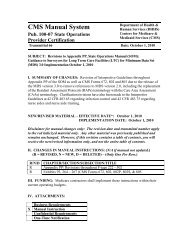2003 Louisiana Vital Statistics Report - Louisiana Department of ...
2003 Louisiana Vital Statistics Report - Louisiana Department of ...
2003 Louisiana Vital Statistics Report - Louisiana Department of ...
You also want an ePaper? Increase the reach of your titles
YUMPU automatically turns print PDFs into web optimized ePapers that Google loves.
<strong>2003</strong> LOUISIANA VITAL STATISTICS REPORT TECHNICAL NOTES<br />
<strong>of</strong> age occurring in a given population during one year by the number <strong>of</strong> stillbirths plus live births occurring during that year, then<br />
multiplying the quotient by 1,000. The rate is expressed as the number <strong>of</strong> fetal deaths plus deaths to infants under age 7 days,<br />
per 1,000 stillbirths plus live births.<br />
POSTNEONATAL MORTALITY: a representation <strong>of</strong> deaths occurring to infants aged 28 days through 364 days. Postneonatal<br />
mortality is influenced by environmental factors, such as nutrition, hygiene, and accidents. Advances in neonatology have<br />
blurred the distinction between neonatal and postneonatal mortality, given the improved survival rate <strong>of</strong> premature infants.<br />
POSTNEONATAL MORTALITY RATE: a measure <strong>of</strong> deaths occurring among infants aged 28 days through 364 days during a<br />
given period. Postneonatal mortality rates are calculated by dividing the number <strong>of</strong> deaths occurring to infants aged 28 days<br />
through 364 days in a given population during one year by the number <strong>of</strong> live births occurring during that year, then multiplying<br />
the quotient by 1,000. The rate is expressed as the number <strong>of</strong> deaths to infants aged 28 days through 364 days, per 1,000 live<br />
births.<br />
PRENATAL CARE: health care, counseling, and related services provided during pregnancy to assure the best possible health<br />
for both mother and child. Care should start in the first trimester and continue throughout pregnancy. One major focus <strong>of</strong> such<br />
care is screening/monitoring to identify conditions that might threaten the mother or the child. A second major focus is<br />
counseling and guidance relative to diet, alcohol, tobacco, and other health concerns. Other services, for those who qualify, are<br />
social and financial counseling, WIC, and Medicaid.<br />
PRE-TEEN BIRTH: a birth to a woman younger than 13 years old.<br />
RATE: a measure used to make comparisons among different groups. A rate is the number <strong>of</strong> specific health events in a given<br />
time period divided by the average population during that same period, then multiplied by a number such as 1,000 or 100,000 to<br />
facilitate comparison between different populations. Multiplying by 100 results in a percentage <strong>of</strong> events per time period, which<br />
is an expression <strong>of</strong> the number <strong>of</strong> people out <strong>of</strong> 100 who experienced the event during the period. Most rates, however, are<br />
given as the number out <strong>of</strong> 1,000 or 100,000, because when rates are based on very small numbers, it is easier to understand<br />
the numbers and to compare the rates this way. Rates can be used to measure changes in the occurrence <strong>of</strong> health events<br />
between different time periods and geographical areas etc.<br />
RESIDENCE: defined as that <strong>of</strong> the deceased for a death and as that <strong>of</strong> the mother for a birth or stillbirth. Births and deaths<br />
occurring in institutions in <strong>Louisiana</strong> are reallocated to the place <strong>of</strong> previous residence, regardless <strong>of</strong> length <strong>of</strong> stay in the<br />
institution. All tables in this publication refer to resident events except as noted.<br />
RACE: the category that is shown on the certificate. Tables that include race classification are tabulated by white, black, and<br />
other, where other includes all races not white or black. Beginning in 1989, birth data are presented by race <strong>of</strong> mother rather<br />
than inferred race <strong>of</strong> child.<br />
SPONTANEOUS FETAL DEATH: a fetal death that is not an induced termination <strong>of</strong> pregnancy. Spontaneous fetal deaths <strong>of</strong><br />
20 weeks or more duration <strong>of</strong> pregnancy, or with a weight <strong>of</strong> 350 grams or more, must be reported on a Fetal Death (Stillbirth)<br />
certificate. For details <strong>of</strong> the <strong>Louisiana</strong> and National Center for Health <strong>Statistics</strong> definitions <strong>of</strong> fetal death, please refer to the<br />
Spontaneous Fetal Death Data section <strong>of</strong> these Technical Notes, on page 157.<br />
<strong>Louisiana</strong> Office <strong>of</strong> Public Health, State Center for Health <strong>Statistics</strong> Page 169
















